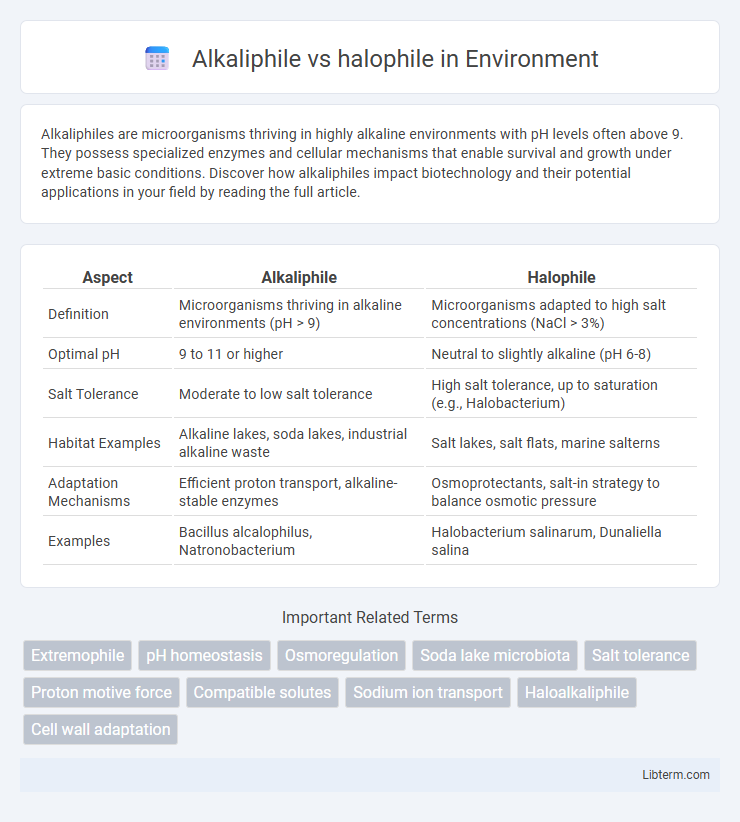Alkaliphiles are microorganisms thriving in highly alkaline environments with pH levels often above 9. They possess specialized enzymes and cellular mechanisms that enable survival and growth under extreme basic conditions. Discover how alkaliphiles impact biotechnology and their potential applications in your field by reading the full article.
Table of Comparison
| Aspect | Alkaliphile | Halophile |
|---|---|---|
| Definition | Microorganisms thriving in alkaline environments (pH > 9) | Microorganisms adapted to high salt concentrations (NaCl > 3%) |
| Optimal pH | 9 to 11 or higher | Neutral to slightly alkaline (pH 6-8) |
| Salt Tolerance | Moderate to low salt tolerance | High salt tolerance, up to saturation (e.g., Halobacterium) |
| Habitat Examples | Alkaline lakes, soda lakes, industrial alkaline waste | Salt lakes, salt flats, marine salterns |
| Adaptation Mechanisms | Efficient proton transport, alkaline-stable enzymes | Osmoprotectants, salt-in strategy to balance osmotic pressure |
| Examples | Bacillus alcalophilus, Natronobacterium | Halobacterium salinarum, Dunaliella salina |
Introduction to Alkaliphiles and Halophiles
Alkaliphiles are microorganisms thriving in environments with high pH levels, often above 9, such as soda lakes and alkaline soils, while halophiles inhabit hypersaline environments like salt lakes and salt mines, requiring high salt concentrations for growth. These extremophiles exhibit specialized adaptations, including unique enzyme systems and cellular mechanisms, to survive in harsh alkaline or saline conditions. Understanding alkaliphiles and halophiles is essential for biotechnology applications, such as enzyme production and bioremediation in extreme environments.
Defining Alkaliphiles: Key Characteristics
Alkaliphiles are microorganisms that thrive in environments with a pH typically above 9, exhibiting optimal growth in highly alkaline conditions such as soda lakes and alkaline soils. Key characteristics of alkaliphiles include specialized cellular mechanisms for maintaining internal pH homeostasis, such as robust proton pumps and sodium ion transport systems that prevent cytoplasmic alkalization. These adaptations enable alkaliphiles to sustain metabolic processes and enzyme function in extreme alkalinity, distinguishing them from halophiles, which primarily adapt to high salt concentrations rather than extreme pH.
Understanding Halophiles: Core Features
Halophiles are extremophilic microorganisms thriving in high-salt environments, typically requiring salt concentrations up to 20-30% NaCl for optimal growth. They possess specialized cellular mechanisms such as salt-in cytoplasm strategy and compatible solute accumulation to maintain osmotic balance and protein stability. Unlike alkaliphiles that prefer high pH, halophiles' core features revolve around salt tolerance, including unique membrane lipids and ion pumps adapted to hyper-saline habitats like salt lakes and saline soils.
Environmental Niches of Alkaliphiles
Alkaliphiles thrive in extreme environments with high pH levels typically above 9, such as soda lakes, alkaline soils, and industrial waste sites. These microorganisms have specialized adaptive mechanisms allowing them to maintain intracellular pH homeostasis and enzymatic function despite the alkaline conditions. Their environmental niches are distinct from halophiles, which predominantly inhabit high-salinity environments like salt flats, saline lakes, and marine salterns.
Natural Habitats of Halophiles
Halophiles thrive in natural habitats characterized by high salt concentrations, such as salt lakes, saline soils, and salt mines, where salt levels often exceed 20%. These environments include the Dead Sea, Great Salt Lake, and salt pans, providing extreme conditions that select for microorganisms adapted to osmotic stress. In contrast, alkaliphiles prefer environments with high pH values, like soda lakes and alkaline soils, but do not require elevated salinity.
Mechanisms of pH Adaptation in Alkaliphiles
Alkaliphiles adapt to high pH environments by employing robust proton motive force mechanisms and utilizing specialized cell wall structures that prevent cytoplasmic alkalinization. Their Na+/H+ antiporters actively expel sodium ions while importing protons to maintain intracellular pH homeostasis. In contrast, halophiles primarily adapt to high salt concentrations through osmoprotectant accumulation rather than pH regulation.
Salt Tolerance Strategies in Halophiles
Halophiles utilize specialized salt tolerance strategies involving compatible solute accumulation and ion transport systems to maintain cellular osmotic balance in high-salinity environments. In contrast, alkaliphiles adapt primarily to high pH conditions through robust pH homeostasis mechanisms but do not rely extensively on salt-specific adaptations. Understanding halophilic osmoprotection, including the synthesis of organic osmolytes like ectoine and uptake of K+ ions, provides insight into their survival in extreme saline habitats.
Industrial and Biotechnological Applications
Alkaliphiles thrive in high pH environments and produce alkaline-stable enzymes such as proteases and cellulases, which are extensively used in detergent formulations, textile processing, and paper industries. Halophiles, adapted to high salt concentrations, generate salt-tolerant enzymes and compatible solutes valuable for bioremediation, food fermentation, and biosynthesis of bioplastics in hypersaline conditions. Both extremophiles offer unique metabolic pathways and robust biomolecules that enhance industrial processes under extreme pH and salinity, reducing contamination risks and improving efficiency.
Comparative Genomics: Alkaliphile vs Halophile
Comparative genomics of alkaliphiles and halophiles reveals distinct adaptations to extreme pH and salinity environments, respectively, highlighting specialized gene clusters for ion transport and osmoprotection. Alkaliphiles possess unique Na+/H+ antiporters enabling pH homeostasis under alkaline conditions, while halophiles exhibit expanded gene families encoding compatible solute synthesis and salt-in strategies for osmotic balance. Genomic analyses emphasize convergent evolutionary mechanisms driving environmental resilience but divergent molecular pathways tailored to high pH versus hypersaline niches.
Future Perspectives and Research Directions
Future research on alkaliphiles and halophiles emphasizes exploring their unique extremozymes for sustainable industrial applications like bioremediation and biofuel production. Advances in genomics and synthetic biology are expected to unlock new metabolic pathways, enhancing their efficiency in extreme conditions. Investigating microbial interactions in extreme environments may reveal novel bioactive compounds with potential pharmaceutical uses.
Alkaliphile Infographic

 libterm.com
libterm.com